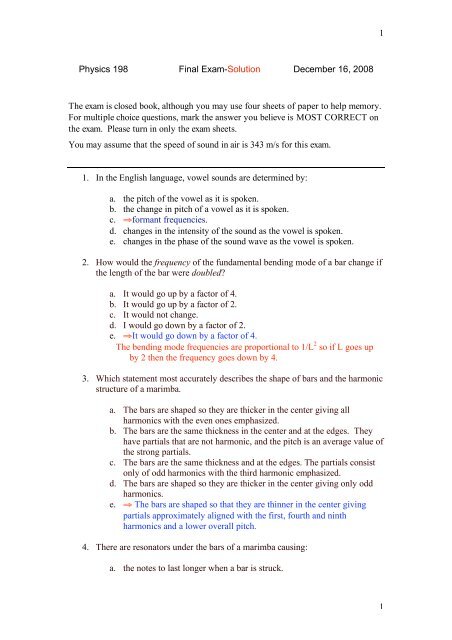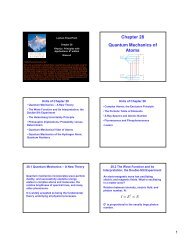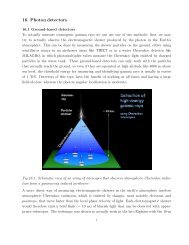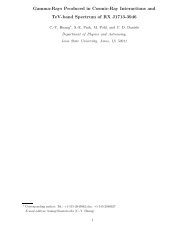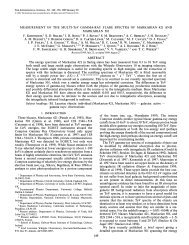1 1 Physics 198 Final Exam-Solution December 16, 2008 The exam ...
1 1 Physics 198 Final Exam-Solution December 16, 2008 The exam ...
1 1 Physics 198 Final Exam-Solution December 16, 2008 The exam ...
You also want an ePaper? Increase the reach of your titles
YUMPU automatically turns print PDFs into web optimized ePapers that Google loves.
1<br />
<strong>Physics</strong> <strong>198</strong> <strong>Final</strong> <strong>Exam</strong>-<strong>Solution</strong> <strong>December</strong> <strong>16</strong>, <strong>2008</strong><br />
<strong>The</strong> <strong>exam</strong> is closed book, although you may use four sheets of paper to help memory.<br />
For multiple choice questions, mark the answer you believe is MOST CORRECT on<br />
the <strong>exam</strong>. Please turn in only the <strong>exam</strong> sheets.<br />
You may assume that the speed of sound in air is 343 m/s for this <strong>exam</strong>.<br />
1. In the English language, vowel sounds are determined by:<br />
a. the pitch of the vowel as it is spoken.<br />
b. the change in pitch of a vowel as it is spoken.<br />
c. ⇒formant frequencies.<br />
d. changes in the intensity of the sound as the vowel is spoken.<br />
e. changes in the phase of the sound wave as the vowel is spoken.<br />
2. How would the frequency of the fundamental bending mode of a bar change if<br />
the length of the bar were doubled?<br />
a. It would go up by a factor of 4.<br />
b. It would go up by a factor of 2.<br />
c. It would not change.<br />
d. I would go down by a factor of 2.<br />
e. ⇒It would go down by a factor of 4.<br />
<strong>The</strong> bending mode frequencies are proportional to 1/L 2 so if L goes up<br />
by 2 then the frequency goes down by 4.<br />
3. Which statement most accurately describes the shape of bars and the harmonic<br />
structure of a marimba.<br />
a. <strong>The</strong> bars are shaped so they are thicker in the center giving all<br />
harmonics with the even ones emphasized.<br />
b. <strong>The</strong> bars are the same thickness in the center and at the edges. <strong>The</strong>y<br />
have partials that are not harmonic, and the pitch is an average value of<br />
the strong partials.<br />
c. <strong>The</strong> bars are the same thickness and at the edges. <strong>The</strong> partials consist<br />
only of odd harmonics with the third harmonic emphasized.<br />
d. <strong>The</strong> bars are shaped so they are thicker in the center giving only odd<br />
harmonics.<br />
e. ⇒ <strong>The</strong> bars are shaped so that they are thinner in the center giving<br />
partials approximately aligned with the first, fourth and ninth<br />
harmonics and a lower overall pitch.<br />
4. <strong>The</strong>re are resonators under the bars of a marimba causing:<br />
a. the notes to last longer when a bar is struck.<br />
1
2<br />
b. the fundamental would be diminished in relation to the higher<br />
harmonics giving a more brilliant tone<br />
c. ⇒the fundamental to be coupled more effectively to the air<br />
emphasizing the fundamental and decreasing the length of a note.<br />
d. Marimbas do not have resonators under the bars.<br />
5. <strong>The</strong> normal primary vibration mode of a tympani is<br />
a. <strong>The</strong> (0,1) mode that has no nodal lines through the center and a nodal<br />
circle only at the rim. <strong>The</strong> drum is struck at its center to strongly<br />
excite this mode.<br />
b. ⇒<strong>The</strong> (1,1) mode that has a single nodal line through the center and a<br />
nodal circle only at the rim. <strong>The</strong> drum is struck a point somewhere<br />
between the center and the rim to strongly excite this mode.<br />
c. <strong>The</strong> (0,2) “sombrero” mode that has no nodal lines through the center,<br />
a nodal circle at the rim and another nodal circle between the rim and<br />
the center. <strong>The</strong> drum is struck at its center to strongly excite this<br />
mode.<br />
6. What instrument has “stretched octaves”? ⇒ piano<br />
<strong>The</strong> strings have some resistance to bending that implies that the overtones<br />
are not exactly harmonic: the first overtone slightly exceeds a factor of<br />
two. Since the octaves are tuned to be without beats, this implies that the<br />
octaves are very slightly stretched.<br />
7. Which of the following would have the smallest reverberation time?<br />
a. ⇒A room the size of the <strong>Physics</strong> <strong>198</strong> lab room with walls and ceiling<br />
covered with felt.<br />
b. A room the size of the <strong>Physics</strong> <strong>198</strong> lab room with walls and ceiling<br />
covered with standard (hard) painted sheetrock.<br />
c. A room the size of the <strong>Physics</strong> <strong>198</strong> lecture hall with walls and ceiling<br />
covered with felt.<br />
d. A room the size of the <strong>Physics</strong> <strong>198</strong> lecture hall with walls and ceiling<br />
covered with standard (hard) painted sheetrock.<br />
8. Give one advantage and one disadvantage of increasing absorption to obtain a<br />
short reverberation time. ⇒ A short reverberation time implies that very fast<br />
music is possible and speech should be distinct. However people have less of<br />
a feeling of being “bathed in reverberant sound,” and the sound level will be<br />
lower perhaps requiring amplification.<br />
9. What is the criterion in acoustics for an “intimate” concert hall? ⇒ That the<br />
time between the direct sound and 1 st reflected sound is short, about 20 ms or<br />
less.<br />
2
3<br />
10. A talented flute player blows over the top of a long tube with both ends open<br />
that emits sound. Sketch the standing wave pattern for the first overtone (not<br />
the fundamental!) inside the picture of the tube below. Label the nodes and<br />
antinodes.<br />
11. Assuming that the tube in problem 10 is 0.343 meters long, and that the<br />
diameter is small enough to neglect end effects, what are the frequencies of the<br />
fundamental and first overtone?<br />
⇒ All harmonics are present for an open/open pipe.<br />
f 1 = v/(2L) = 343/(2*.343) = 1000/2 = 500 Hz; f 2 = 1000 Hz.<br />
12. <strong>The</strong> flutist in problem 10 then covers the far end of the 0.343-meter tube with<br />
her hand and again blows over the tube again, and the open/closed tube emits<br />
sound. Sketch the standing wave pattern for the first overtone (not<br />
fundamental!) inside the picture of the tube below. Label the nodes and<br />
antinodes.<br />
13. Assuming that the open/closed tube in Problem 12 is 0.343 meters long, and<br />
that the diameter is small enough to neglect end effects, what are the<br />
frequencies of the fundamental and first overtone? ? ⇒ Only odd harmonics<br />
are present for an open/closed pipe.<br />
f 1 = v/(4L) = 343/(4*.343) = 1000/4 = 250 Hz; f 3 = 750 Hz.<br />
14. What is the wavelength in meters in air of a wave with frequency of 1029 Hz?<br />
a. 1/4 = 0.25<br />
b. 1/3 = 0.33 ⇒ λ = v/f = 343/1029 = 1/3 = 0.33<br />
c. 1/2 = 0.50<br />
d. 2<br />
e. 3<br />
f. 4<br />
3
4<br />
15. A mass m=0.25 kg is attached to an ideal spring and the mass-spring system<br />
undergoes simple harmonic motion with no friction. If the mass is increased<br />
by a factor of four to 1.0 kg, how will the frequency of oscillation change?<br />
a. It does not change.<br />
b. It goes up (faster oscillations) by a factor of four.<br />
c. It does up (faster oscillations) by a factor of two.<br />
d. ⇒It goes down (slower oscillations) by a factor of two<br />
f = (1/(2π))*√(k/m) so multiplying m by 4 divides f by 2.<br />
<strong>16</strong>. If the spring-mass simple harmonic system in Problem 13 has a spring<br />
constant k = 10N/m and the mass is pulled 0.1 meters from equilibrium and<br />
released at rest, what is the potential energy in Joules in the system just before<br />
the mass is released?<br />
a. ⇒ 0.05 PE = ½ k x 2 = ½*10*0.1*0.1 = 0.05<br />
b. 0.10<br />
c. 0.50<br />
d. 1.00<br />
e. 5.00<br />
17. A sound pressure pulse is reflected from the closed end of a tube. <strong>The</strong><br />
reflected sound pulse is:<br />
a. inverted (positive becomes negative)<br />
b. ⇒ non-inverted (positive remains positive)<br />
c. non-existent (pulse disappears at the tube end)<br />
d. can be either inverted or non-inverted depending on the tube length.<br />
18. <strong>The</strong> tube between the pinna and the eardrum is:<br />
a. the Eustachian tube.<br />
b. ⇒ the auditory canal.<br />
c. the ossicles.<br />
d. the stapes.<br />
e. the cochlea.<br />
19. In one to three clear sentences, explain the “place” theory of pitch.<br />
⇒ <strong>The</strong> basilar membrane vibrates at different frequencies along its length, and<br />
the brain knows what part is vibrating from sensor cells firing that have hairs<br />
touching the membrane. Hence the “place” refers to the place on the<br />
membrane that vibrates.<br />
4
5<br />
20. A single concertina player on stage in Bandshell park plays to produce a<br />
sound intensity level of 74 dB at a distance of 24 feet from the stage. How<br />
many identical concertina players playing exactly the same note would<br />
produce an intensity level of 86 dB at the same distance? (Careful!)<br />
a. 2<br />
b. 4<br />
c. 8<br />
d. ⇒<strong>16</strong> [doubling gives 3 dB and (86-74)/3=4 so must double 4<br />
times⇒ 2, 4, 8, <strong>16</strong>]<br />
e. more concertina players than are in the state of Iowa (perhaps true,<br />
but no credit for this!)<br />
21. If the concertina players now produce 86 dB at 24 feet from the stage what<br />
would be the sound intensity level in dB at 48 feet from the stage?<br />
a. 84 b. 82 c. ⇒80 d. 78 e. 76 f. 74<br />
L I drops 6 dB when distance is doubled: 86 – 6 = 80<br />
22. <strong>The</strong> most sensitive part of one’s hearing range is nearest which frequency<br />
(Hz).<br />
a. 4 b. 40 c. 400 d. ⇒ 4000 e. 40000<br />
23. <strong>The</strong> just noticeable difference (jnd) in pitch in the range for a person with a<br />
good ear at an optimal part of the hearing range (1-4 kHz) is approximately:<br />
a. 1/1000 of a half-step<br />
b. ⇒ 1/10 of a half step<br />
c. 1 half step<br />
d. 4 half steps<br />
e.<br />
24. A sawtooth wave at 250 Hz is played together with a squarewave at 101 Hz.<br />
Will there be audible beats in any of the lower harmonics of the two waves?<br />
a. Yes, 1 beat per second at about 202 Hz<br />
b. Yes, 2 beats per second at about 251 Hz<br />
c. Yes, 3 beats per second at about 303 Hz<br />
d. ⇒ Yes, 5 beats per second at about 502 Hz.<br />
e. <strong>The</strong>re will be no audible beats in the harmonics.<br />
Sawtooth has all harmonics: 250, 500, 750, …; Square has odd harmonics: 101,<br />
303, 505,…; so beats of 5 Hz will occur at about (500+505)/2 = 502<br />
25. Two pure (only the fundamental is present) tones seem are dissonant if<br />
a. they differ in frequency by about ¼ of a critical band.<br />
b. they differ in frequency by about 2 critical bands.<br />
c. they differ in frequency by about 4 critical bands.<br />
d. they differ in frequency by more than 4 kHz.<br />
5
6<br />
26. If we choose to tune C 4 to 260 Hz as the first note in a Pythagorean scale, what<br />
would be the frequency of G 4 which is a 5’th higher? <strong>The</strong> fifth’s are perfect in<br />
Pythagorean scale give a ratio of 3/2. Hence (3/2)*260 = 3*130 =<br />
⇒ 390 Hz.<br />
27. Which tuning/temperament (Pythagorean, mean, just, equal) exactly closes the<br />
circle of 5’ths?<br />
⇒ Equal Temperament<br />
28. Briefly but clearly explain the advantage of multiple pickups on an electric<br />
guitar.<br />
⇒ <strong>The</strong> anti-nodes for different harmonics occur in different places, and the<br />
anti-node locations also change as frets are used. If several pickups are<br />
used, all harmonic strengths can be sampled and mixed electronically.<br />
29. In lecture, Simon kindly demonstrated a “pedal” tone with his tuba; Nolan<br />
(trombone) and Ross and Chad (trumpets) later played these in labs. Which is<br />
the most accurate description.<br />
a. A pedal tone is the highest peak in the harmonic series of brass<br />
instruments, and is often beyond one’s hearing range in pitch.<br />
b. ⇒ A pedal tone is the lowest note in the harmonic sequence for a<br />
brass instrument. <strong>The</strong> instrument does not actually have a resonance<br />
there, but, when the instrument is played, the lips can be stabilized at<br />
this frequency by the higher harmonics that do exist in the horn.<br />
c. A pedal tone is obtained by “popping” the mouthpiece giving a<br />
frequency of about 800 Hz.<br />
30. Briefly but clearly explain what Formant Tuning is and where it is used in<br />
music.<br />
⇒ It is possible to align one of the resonant frequencies one of the vocal<br />
cavities (formants) with the frequency of the note being sung. This<br />
can give the sound great power. This is useful at the top end of the<br />
soprano range where the note frequency is above most vowel<br />
formants. I believe that Tom also used it effectively in his<br />
demonstration of “throat singing” in lecture and in lab as well. (<strong>The</strong><br />
first sentence is sufficient for full credit.)<br />
End of <strong>Exam</strong> and End of Course!<br />
Have a Great Winter Break!<br />
6


